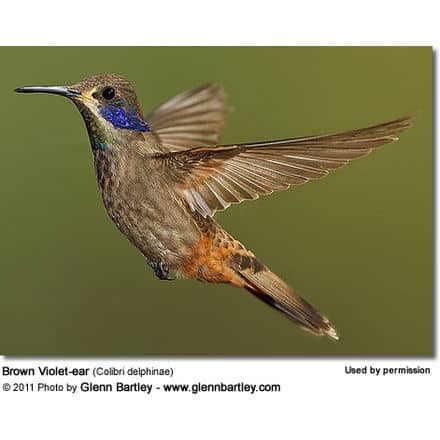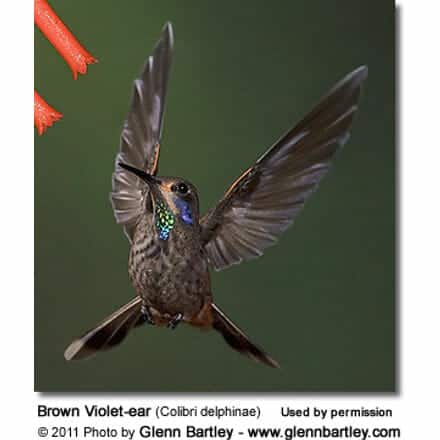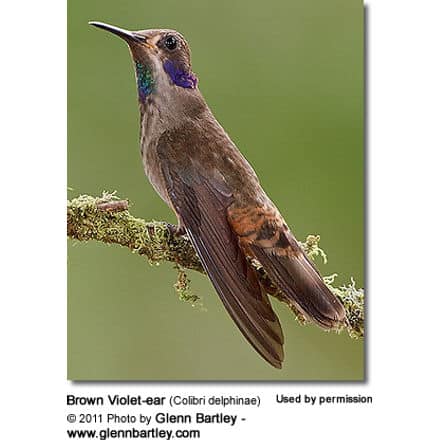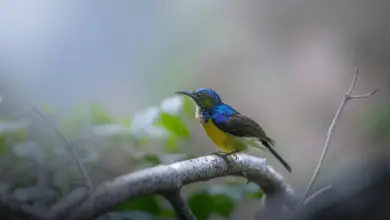Brown Violet-ear Hummingbirds
The Brown Violet-ear Hummingbirds (Colibri delphinae) is a large South American hummingbird.
Alternate (Global) Names
Spanish: Colibrí orejivioláceo pardo, Colibrí Pardo, Colibrí Pardore, Orejavioleta Café, Orejimorada café … Portuguese: Beija-flor-marrom, beija-flor-marrom-de-orelha-azul … French: Colibri de Delphine … Italian: Colibrì orecchieviola bruno, Guanciaviola bruno … Czech: kolib?ík fialovouchý, Kolibrík telesillský … Danish: Brun Violetøre … German: Brauner Veilchenohrkolibri, Telesilla Kolibri, Telesillakolibri … Finnish: Rusko-orvokkikolibri … Japanese: chairohachidori … Dutch: Bruine Violetoorkolibrie … Norwegian: Brunkolibri … Polish: uszatek brazowy, uszatek br?zowy … Russian: ????? ??????? … Slovak: jagavicka hnedá … Swedish: Brunkolibri

Distribution / Range
The Brown Violet-ear breeds at middle elevations in the hills from Guatemala south to Bolivia and eastern Brazil, as well as on Trinidad – at elevations from 400 to 1600 m.
Outside the breeding season, the Brown Violet-ear may move into the lowlands.
The Brown Violet-ear Hummingbirds is typically found high in the forest canopy, tall second growth, and coffee plantations, but it will feed at lower levels at edges and clearings.
Hummingbird Resources
- Hummingbird Information
- Hummingbird Amazing Facts
- Attracting Hummingbirds to Your Garden
- Hummingbird Species
- Feeding Hummingbirds
Description
The Brown Violet-ear Hummingbirds averages 11.5 cm in length and 6.5-7 g in weight.
It can easily be identified by the violet patch running back and down from the eye, a hermit-like malar (cheek) stripe, and a glittering green central throat.
The plumage is mostly dull brown, with a rufous rump and greyer underparts. Its beak is short and straight.
The female looks like the male but has a smaller throat patch.
Young Brown Violet-ears have rufous edges to the upper plumage, and little or no violet behind the eyes.

Nesting / Breeding
Hummingbirds are solitary in all aspects of life other than breeding, and the male’s only involvement in the reproductive process is the actual mating with the female. They neither live nor migrate in flocks, and there is no pair bond for this species.
Males court females by flying in a U-shaped pattern in front of them. He will separate from the female immediately after copulation. One male may mate with several females.
In all likelihood, the female will also mate with several males. The males do not participate in choosing the nest location, building the nest, or raising the chicks.
The female Brown Violet-ear is responsible for building a small cup-shaped nest out of green moss lining it with other soft plant fibers, and strengthening the structure with spider webbing. The nest is typically found on a twig 1-3 m high in the bush.
The average clutch consists of two white eggs, which she incubates alone, while the male defends his territory and the flowers he feeds on. The young are born blind, immobile, and without any down.
The female alone protects and feeds the chicks with regurgitated food (mostly partially digested insects since nectar is an insufficient source of protein for the growing chicks). The female pushes the food down the chicks’ throats with her long bill directly into their stomachs.
As is the case with other hummingbird species, the chicks are brooded only the first week or two and are left alone even on cooler nights after about 12 days – probably due to the small nest size. The chicks leave the nest when they are about 7 – 10 days old.
Diet / Feeding
The Brown Violet-ears Hummingbirds primarily feed on nectar taken from a variety of brightly colored, scented small flowers of trees, herbs, shrubs, and epiphytes. They favor flowers with the highest sugar content (often red-colored and tubular-shaped) and seek out, and aggressively protect, those areas containing flowers with high-energy nectar.
They use their long, extendible, straw-like tongues to retrieve the nectar while hovering with their tails cocked upward as they are licking at the nectar up to 13 times per second. Sometimes they may be seen hanging on the flower while feeding.
Many native and cultivated plants on whose flowers these birds feed heavily rely on them for pollination. The mostly tubular-shaped flowers exclude most bees and butterflies from feeding on them and, subsequently, from pollinating the plants.
Song / Vocalizations
Its song consists of a vigorous repetition of the chit call usually sung by several dozen breeding males in loose leks (= gathering of males for competitive mating displays).








